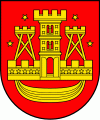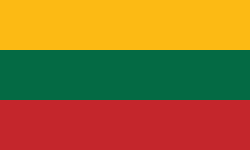Klaipėda
 |
The city has a complex recorded history, partially due to the combined regional importance of the usually ice-free Port of Klaipėda at the mouth of the river Akmena-Danë. Located in the region of Lithuania Minor, at various times, it was a part of the Polish–Lithuanian Commonwealth, Prussia and Germany until the 1919 Treaty of Versailles. As a result of the 1923 Klaipėda Revolt it was annexed by Lithuania and has remained with Lithuania to this day, except between 1939 and 1945 when it was occupied by Germany following the 1939 German ultimatum to Lithuania.
The population has migrated from the city to its suburbs and hinterland. The number of inhabitants of Klaipėda city shrank from 202,929 in 1989 to 162,360 in 2011, but the urban zone of Klaipėda expanded well into the suburbs, which sprang up around the city and surrounded it from three sides. These are partly integrated with the city (city bus lines, city water supply, etc.) and the majority of inhabitants of these suburbs work in Klaipėda. According to data from the Department of Statistics, there are 212,302 permanent inhabitants (as of 2020) in Klaipėda city and Klaipėda district municipalities combined. Popular seaside resorts found close to Klaipėda are Neringa to the south on the Curonian Spit and Palanga to the north.
The Teutonic Knights built a castle in the *Pilsāts Land of the Curonians and named it Memelburg; later the name was shortened to Memel. From 1252 to 1923 and from 1939 to 1945, the town and city were officially named Memel. Between 1923 and 1939, both names were in official use; since 1945 the Lithuanian name of Klaipėda has been used.
The names Memelburg and Memel are found in most written sources from the 13th century onwards, while Klaipėda is found in Lithuania-related sources since the 15th century. The first time the city was mentioned as Caloypede in the letter of Vytautas in 1413, for the second time in the negotiation documents of 1420 as Klawppeda, and for the third time in the Treaty of Melno of 1422 as Cleupeda. According to Samogitian folk etymology, the name Klaipėda refers to the boggy terrain of the town (klaidyti=obstruct and pėda=foot). Most likely the name is of Curonian origin and means "even ground": "klais/klait" (flat, open, free) and "peda" (sole of the foot, ground), as a reference to relatively flat terrain of the original settlement's surroundings.
The lower reaches of the river Neman were named either *Mēmele or *Mēmela by Scalovians and local Curonian inhabitants. In the Latvian Curonian language it means mute, silent (memelis, mimelis, mēms), as a reference to peaceful flow of the Neman. This name was adopted by speakers of German and also chosen for the new city founded further away at the lagoon.
Map - Klaipėda
Map
Country - Lithuanian_Soviet_Socialist_Republic_(1918–1919)
 |
 |
| Flag of Lithuania | |
Germany had lost World War I and signed the Compiègne Armistice on 11 November 1918. Its military forces then started retreating from the former Ober Ost territories. Two days later, the government of the Soviet Russia renounced the Treaty of Brest-Litovsk, which had assured Lithuania's independence. Soviet forces then launched a westward offensive against Estonia, Latvia, Lithuania, Poland and Ukraine in an effort to spread the global proletarian revolution and replace national independence movements with Soviet republics. Their forces followed retreating German troops and reached Lithuania by the end of December 1918.
Currency / Language
| ISO | Currency | Symbol | Significant figures |
|---|---|---|---|
| EUR | Euro | € | 2 |
| ISO | Language |
|---|---|
| LT | Lithuanian language |
| PL | Polish language |
| RU | Russian language |

















